We quickly forgot the mountains. The desert was a land that required attention, demanded it. The Great Divide Basin was sneaky though, it wasn’t filled with blatant signals like giant saguaros and naked sandstone cliffs. It was covered with soft sage, soft sand and soft rolling hills. For once, we had views of uninterrupted flatness in all directions. We were walking on old roads, and it was easy walking. For moments, it was easy to forget that we were walking on the edge. Nobody could live out there without working at it… all the time.
The CDT shot straight out, into the horizon, the fastest way from A to B. We decided to give ourselves a break. Instead of following the CDT, we could ease into the desert experience. The Sweetwater river headed in generally the right direction. The Sweetwater was an actual river – with water – not just an over-tapped, over-dammed dotted blue line on the map. In fact, we didn’t understand why the trail wasn’t routed along the river… was there some grave unforeseen danger that we’d discover only too late? According to the spirits of South Pass City, walking the river would be no problem, but then, they were spirits, we were just people, weren’t we?
We passed concrete markers designating famous historical trails – the pony express, the Oregon trail, the Mormon trail. For most of their lengths, they had been covered with mega-highways, traversed by hoards of people in days instead of months. But in the Basin, the land had changed little… it was a place where people came to get at least a taste of their roots, hopefully understand and appreciate the physical struggles they no longer had to endure. 60,000 Mormons came each year to visit Willie’s handcart site. Out there, somewhere, 150 years ago, a group of their brethren had gotten stuck in a snowstorm. The story continued that Brigham Young had a vision… He dispatched a rescue team to find the lost party. Most of them had already died, cold and hungry, but it was still considered a miracle. The Mormons now came there to re-enact the migration. They pushed handcarts full of supplies across the desert. On their way to the site, driving buses and SUVs, some of them still managed to get lost.
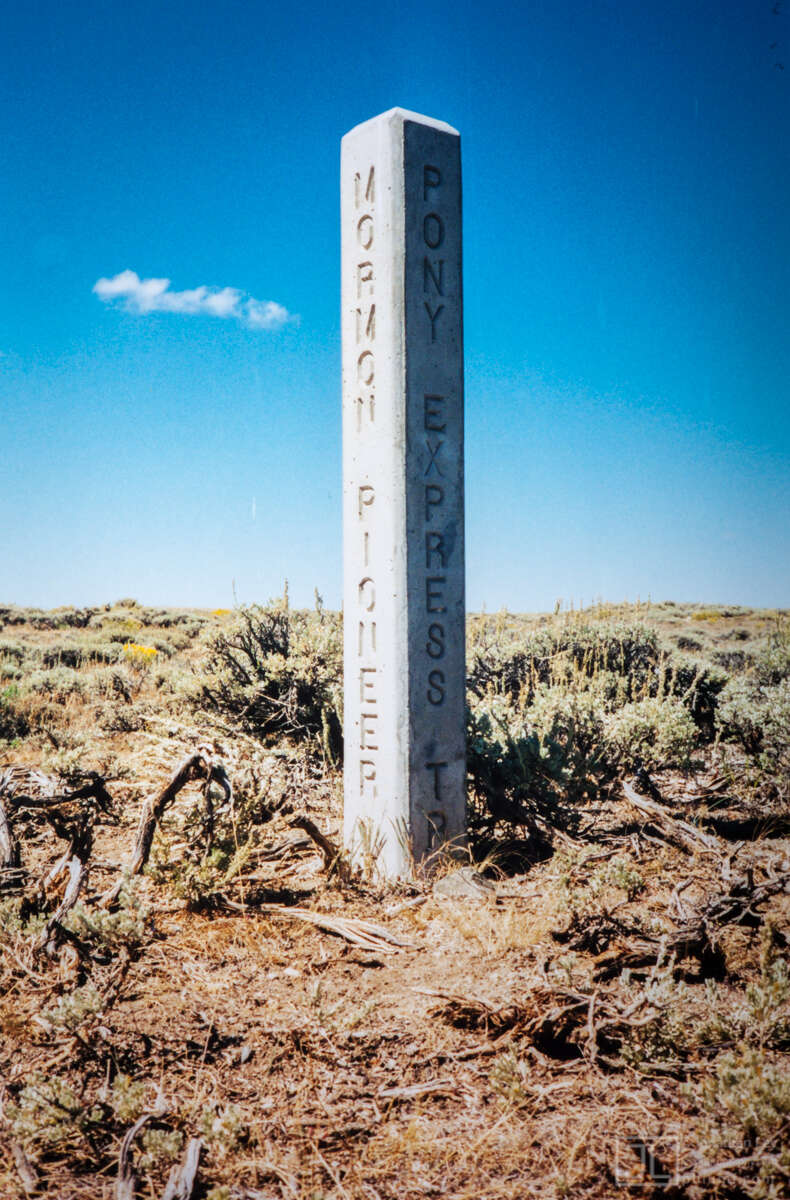
We hit the Sweetwater River and followed it downstream. Cows grazed there, in the desert, by the water. Every patch of green was exploited. The river carved a canyon through the dark desert rock, just deep enough that we could forget where we were for a while. There was only the ankle-deep river, some trees, some grass… We followed the course of the meandering water. Finally, we stopped on a patch of grass – as good as anywhere. The shadow of the sun crept up the canyon wall.
We weren’t sure how long to follow the river. We didn’t have very good maps of it. We figured we’d just somehow know when it was time to climb out. The canyon continued. It wasn’t a dramatic canyon, we weren’t locked in by steep foreboding walls. The river was kind, just passing through. The water came from distant mountains, and flowed to a distant ocean, it had to cross the desert somewhere. We followed grassy banks and occasional cow paths through the trees along the shore, crossing the river when the going got tough on one side or the other. The canyon walls slowly receded, and we came to a dirt road… still following the river. We came to a barbed-wire fence, it was time to head into the desert. We didn’t want to go. We lingered under a shady bush, waiting for the hottest part of the day to pass. Then, we took all the water we could carry and headed south again… grateful for the little respite the Sweetwater had given us from the full force of the desert.
We didn’t know where the next water was, where the trail was, or where we were. We only knew that if we kept heading south, we’d hit the trail somewhere… it was just a matter of actually recognizing the CDT when crossed it. The CDT followed old dirt roads that were cut through the endless sage. The terrain was open enough that we could walk anywhere. We could have wandered aimlessly forever if we’d wanted, but the CDT provided a good route. It would be easier to follow, plus, it passed some water sources along the way. That was our only real focus – water. If we had enough water, the desert would be easy.
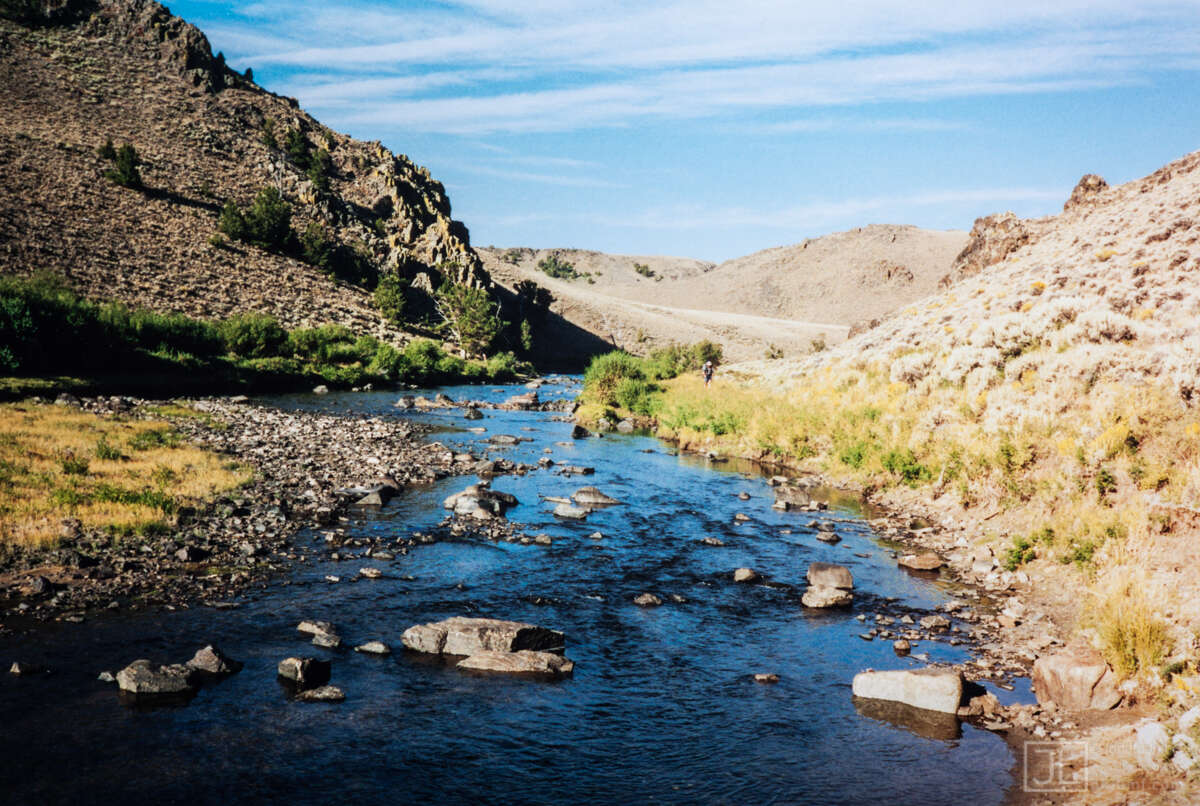
As we headed up the desert hills, the Sweetwater River was visible in the distance. It slowly wound east toward the haze on the horizon, off to the end of the earth it seemed. We passed some roads. Some were nothing more than faint tracks over long dead sage, others were freshly groomed. None of them headed our direction, none of them were the CDT, yet. We finally crested a hill, which, upon reflection, was probably the divide. A mile away, down a hill, we spotted a small green patch next to a couple man-made structures – water. A spring flowed there, water straight out of the sand. Somebody had enough sense to build a fence around the spring, so the wandering cows didn’t wreck it. The spring was a good sign. If it was flowing others would be too. The springs were on our maps – little blue circles with squiggly lines. We knew that some of the mapped springs were good, others were unreliable and dry. We had little idea which was which. We had no way to tell which spring it was that we’d stumbled upon.
I didn’t have my regular maps for the section – those had been in the missing box, we only had a vague idea of what the terrain looked like – our maps showed only roads and springs and dry riverbeds, and showed none of those in much detail. I looked at the suspect springs, was it Ladysmith spring? upper? lower? possibly Immigrant Spring? Mormon Spring? We headed southeast and came to a crossroads. Each crossroads was unique, the angles of the intersecting roads were often as good as signs. It was Ladysmith spring… one of them. The CDT was just ahead. A mile later, we came to another crossroads. Sure enough, a fiberglass post was planted into the ground – CDT.
The CDT was actually well marked in the Basin. We hadn’t seen any CDT trail markers since Montana, but there in the basin, the CDT had a fan. Ray worked for the BLM and was intrigued by the trail. We’d heard about him in Lander, we’d even stopped by the BLM office there. He hadn’t been in, but we did get a copy of some maps he’d created – maps that showed the route of the CDT, and pinpointed possible water sources. We figured he was also responsible for the signs. There were CDT signs at every crossroads in the basin, so many that one would have to work to get lost. The signs made it easy, just follow the line, watch the horizon, watch the sagebrush drift by.

Pronghorn floated over the sage, the fastest land animal in the USA. They were graceful, beautiful, sleek. Their coats were a rich tan on top, a brilliant white underneath. The stately horns on their heads were crowns – the Pronghorn were the royalty of the desert. They stood on hills, either alone or in small groups, keeping watch from a safe distance. As we approached, they disappeared, they ran and circled around for another view. They were constantly wary, constantly alert. We were in their land, to them it was everywhere, all they knew, and they knew it well. The pronghorn thrived there, naturally. In contrast, there were cows. The cows looked lost and confused, cumbersome and awkward. What were they doing there? They were completely alien. The cows were there because of people, people who lacked any sense of creativity, any ability to think outside the cow, people who saw the natural order as one of supply and demand. Small bits of grass grew under the sagebrush, and that was all people needed to know – grass meant cows, cows meant money. They were doing humanity a service, contributing to the all-important cash-machine of commerce. There was no other priority.
The trail dropped down to a gulch where water was trapped in small pools. It was stagnant water, warm and brown. The grass around the pools was cropped to the nibbins by cows. The piles of cow crap were thick – every few feet. We flung aside some of the drier cow patties and made our camp.
Coyotes sang as the sun set. They were songs only a coyote could really understand, but songs anyone might enjoy for their pure outpouring of emotion, an emotion somewhere between terror and love… possibly both at once. The coyotes belonged there, belonged there with the pronghorn and the horned-toads and the desert hares and the ants. We were only visiting, it was obvious.
I had only a liter of water left, but decided to risk thirst rather than filter the mucky pools. The water we’d camped near stank. It was not only the cow’s watering hole, it was their toilet. It was also the tomb for unlucky fish that had wandered up the creek when the water had flowed. They’d suffocated or boiled, and were slowly rotting in shredded pieces on the shore. Even the coyotes wouldn’t touch them. The trail crossed a large stream a few miles away, it was marked as a possible water source on our maps.
We got to the stream. It was a large stream, but one of dried and naked rocks. There were no signs of water, not even mud. I was jealous of Mario, he’d filtered a liter of the muck from the morning… just in case. Still, I hoped for luck ahead, there was a spring in 5 miles, and another spring soon after that… one of them must have water, I thought. The sun rose quickly, it beat down on the ground, not missing anything. The landscape made sense, every bit of life was simple, geared to the very basics – get water, stay cool, eat. I scooped up a horned-toad. It wasn’t a toad at all, but a small lizard, covered in reflective white armor, armor that mimicked the sandy and rocky soil. I held the lizard close to my eye and marveled at its intricate detail – each scale was unique, they all fit together like a miniature 3-D puzzle that was painted in spots of black and tan and grey, painted by the desert. The lizard had tiny little fingers that ended in delicate claws. It blinked at me with a small wrinkled eye and turned its head, “well, what are you going to do with me?”, it asked. Its camouflage had been blown and it was ready to die, expecting it. I set the terrified lizard on the ground and it sat there for an instant, perhaps stunned by its luck. Then it scampered under a bush, free once again, wiser perhaps.
We got to the next source of water, or so we thought. The trail crossed a well-travelled road, and beneath it was a small patch of green. We kicked aside the ever-present cow patties and looked for something wet. The ground was moist mud, hardened by the sun. The mud had been stomped and stomped and scraped by cows. The cows had no concept of desert etiquette, and no hope to learn it. I thought that all the other desert animals must have hated them, “You’re screwing up the water you idiots!”, a proud pronghorn would scream. The cow would reply with its only reply, “MMmmmeeeeuuuuuu” – it’s one-word language that was too crude for translation. There were a couple tiny puddles of brown water in the hoof-prints in the mud. Some sort of oily sheen made iridescent patterns on surface. I turned to John. We didn’t need to say anything anymore, everything had already been said. Mario had another plan though, he was headed to an RV parked on a nearby hill, parked in the middle of absolutely nowhere.
Mario waved to us, “come up here”. We hiked quickly up the hill, hopeful we could avoid drinking the putrid water we’d found. It was an old RV, small, used, probably loved. A mat of artificial grass laid on the ground near the doorway, a folding table covered with small rocks was at the rear. Mario was standing near the table, talking to a middle-aged man who didn’t appear to get many visitors. He was happy to have us though, fellow wanderers. He’d driven there from LA a week earlier, of all the land in the world from which to chose, he’d chosen the Basin. He was there pursuing his passion – the rocks. To him, the desert was littered with treasure. “Oh, these are just petrified wood mostly…”, he told us, dismissing the shiny rocks on the table. “There’s jade out there.”, he said, probably thinking about that time, years ago, when his Dad had first taken him there, when they’d found that one big rock… together, alone in the desert. It was a special secret pleasure that kept him coming back, a search that most people would never understand – hours upon hours, kicking over rocks, looking. As for the ‘finding’? that was secondary, a bonus. “Here, look at this.”, he said, turning over a drab rock to reveal a tiny bit of greenish blue underneath, “This one is small, it isn’t worth anything really.” I didn’t imagine he intended to sell anything he found though, it was just a way for him to explain his passion to others in terms they might understand. That big jade was out there somewhere, and it was probably worth more to him than any amount of mundane green money, all money looked the same. Rocks were stories that couldn’t be bought.
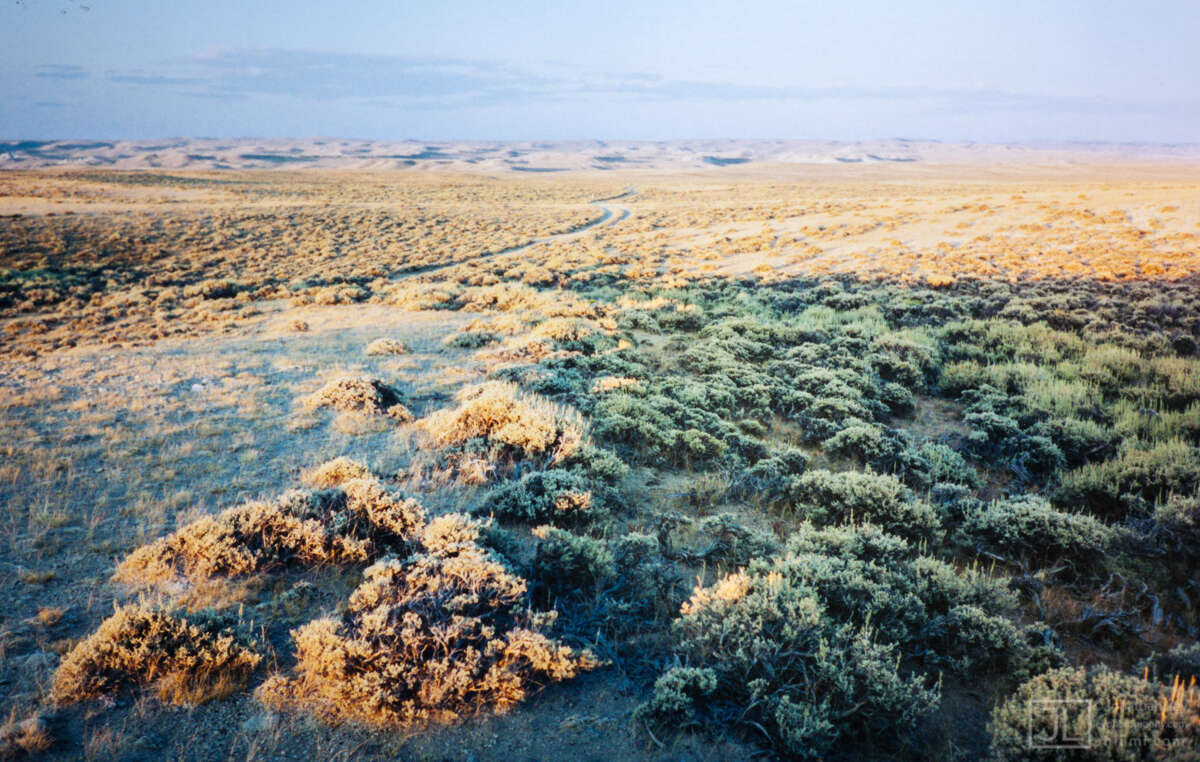
He had a huge container of water. “Take all you want”, he offered, “I’m only out here for a couple more days.” We were more grateful than we could possibly express with words. We had been totally empty, thirsty even, which, in a way was like ‘negative empty’. We quenched our thirst and filled our bottles. It almost felt like cheating, but it was magic. It was a well-known fact to anyone who’d hiked a long trail. There was magic out there, waiting to be found in the most unlikely places, in fact, only in the most unlikely places. Magic wasn’t cheating, it was part of the equation.
The hottest part of the day was nearing. It wasn’t a time for walking, it was a time for resting, for siesta. Those who had never been stuck in the heat with no hope of escape, often made fun of the siesta, like it was some kind of Mexican excuse for laziness. It wasn’t. There was no shade in the Basin, no escape from the sun. In desperation, I set up my rain poncho like a lean-to with my poles and some rope… it actually worked quite nicely. Mario and John baked in the sun, sitting on the dirt, leaning on their packs – it was better than baking on the trail, where the added pressure of walking made the heat hardly bearable. We stayed there an hour, not moving, barely talking, occasionally sipping water. Then at once, we stirred, rose, packed up and headed down the CDT, forever walking.
The flatness of the desert and monotony of the road were wearing on me, but I had found something to keep myself distracted – rocks. I hadn’t really thought about it until I’d met the rock & water guy earlier that day. The floor of the desert was covered with small smooth rocks of all shapes and colors. I had no idea what any of them were technically called, they were just black ones and white ones, red ones and yellow ones, all tinted with a soft quiet shade of earth. Before long my pocket was jingling with the sound of pebbles, every step went chukink, chukink… My eyes scanned the ground, scanned the roadbed, hmmm, I don’t have a green one yet… the miles drifted by, my mind occupied with more important things than thoughts of the CDT.
The trail slowly rose higher, an imperceptible climb with each step. Gradually, we inched up to the highest point in miles. The Basin stretched on to the horizon, it looked much the same as it did from below, only there, probably a thousand feet above the bottom, its true scope was apparent. I had no idea how many miles, or days of walking it was to whatever lay beyond, I only knew it was far, I loved it. To the side of the hill, a small group of horses watched us approach. As we got close, they ran.
If pronghorn were the royalty of the desert, then horses were the rogues. The horse had evolved in America, grown up in Asia, then followed men back across the Atlantic, full circle. Soon after the horses arrived, they got loose. I didn’t know how long horses had been in the Basin, 100 years? 200? 400? Whatever their tenure, they’d found a home. They were doing it on their own terms, they’d settled into the land, and the land had settled into them – rebalancing itself to accommodate the horse. The horses ran everywhere they went. Their heads gently rocked forward and back as their manes and tails caught the wind. I had the impression they loved to run, that they only trotted with men on their backs as a sort of quiet protest. Before that, I had only seen the horse as a product of man, much like the cow, the sheep or the chicken… But those animals had lost any ability to live without the aid of people, much less thrive in a harsh place like the Basin. The horses earned my respect. Their brothers weren’t domesticated by man, they were enslaved. There, roaming free, developing their own systems for survival, evolving their own set of social rules, their beautiful wildness shined through.
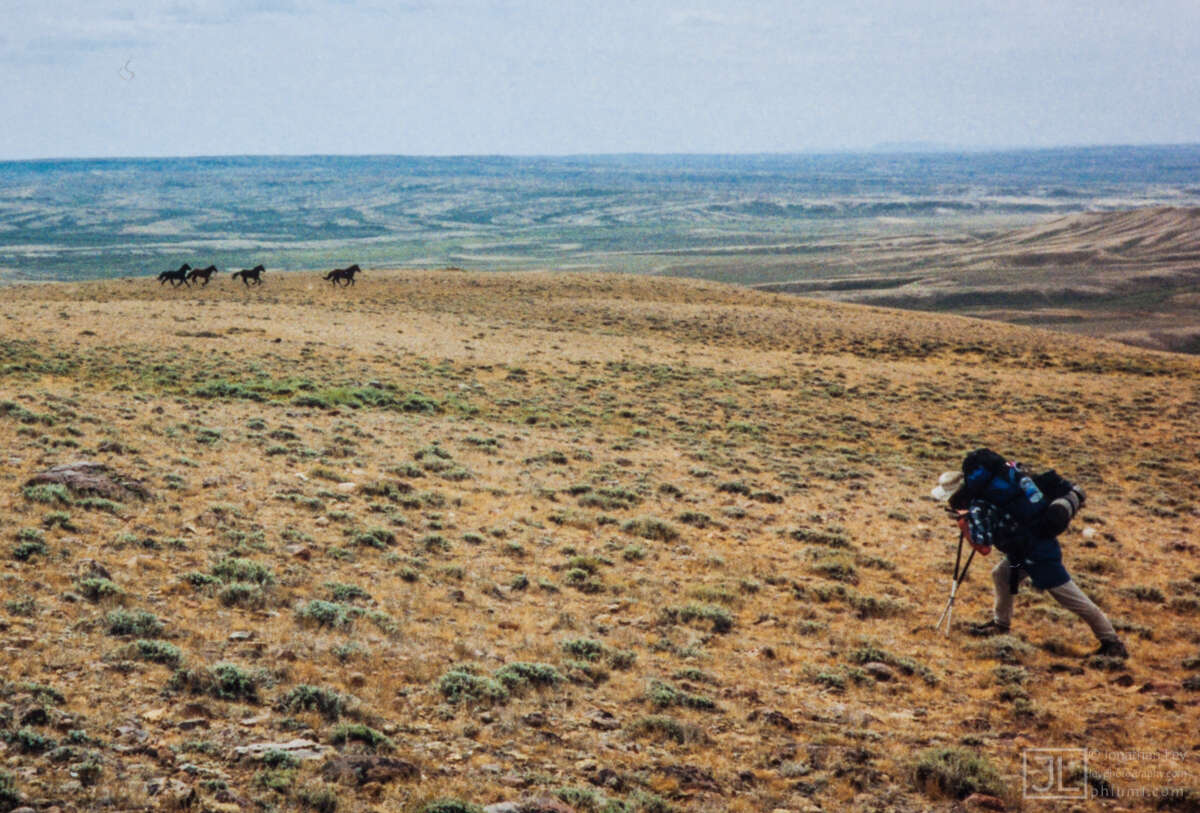
The day grew late and our water supplies dwindled. In the late afternoon, we found ourselves at another water source. Haypress Creek. Somebody had plowed up the earth to make a couple cheap dams. The dams caught any water that ran down the now-dry creekbed. The small pools of water were surrounded on all sides by hard-packed dirt, mud and cow feces. A few ducks floated in one of the pools, and upon our approach they quacked furiously and flew off. As disgusting as it looked, we decided to filter some of the water. It was better than risking a night of thirst, we didn’t completely trust the llama packer’s comments about the next water source, 3 miles ahead.
The llama packer was the author of the other guidebook, the glossy one we didn’t often use. She had hiked the Wyoming CDT, south to north (which was one problem) with a llama (which was another problem) during the spring (yet another problem). The water sources changed quite a bit with the seasons – “flowing nicely” in May often meant “dry” by August… but not always… that was just the problem, we didn’t know. The llama packer had ridden a bike through the Basin, not altogether a bad idea. We didn’t often consult her, but it was usually entertaining, “What’s the llama packer got to say?”, was a fun question to ask.
The llama packer was dead-on. The next water source, Benton Spring, was an oasis in every sense of the word. The spring was some kind of land-management experimental area, a natural water source completely fenced-off from the cows. Inside the fence it was another world – lush, moist, filled with a myriad of plants and insects we hadn’t seen anywhere else in the desert. The absolutely clear water flowed smoothly through abundant and thick knee high grasses. Antelope had no problem jumping the fence, as for horses? I didn’t know. Outside the fence, the cows had obliterated everything within 20 yards. The dirt was hard-packed, bare and dry. The ground was covered in their waste. Slightly farther out, the grass grew to 1-inch, further still, it grew only in fist-sized patches under the never-ending sage. I had to wonder, what did the desert look like before the cows ate all the grass? would all the sage even be there? What kinds of animals and insects once fed-on and hid-in the grass? What others survived on those? Were all the springs once like Benton Spring? Was that little patch all that was left? The clear little steam ran under the fence, out of its natural heritage and into a pile of muddy rocks.
We respected the wishes of the land managers (expressed on a sign) and camped outside the fence, among the cow shit. The sun set behind the hills, lighting up the sky in shades of orange and red, deeper and deeper tones that turned to purple and grey as the night took over.
The next morning, we hurried a few miles down the trail and intersected Crooks Gap Road. We walked a mile or two on the road, then got a ride in the first vehicle to pass by – the bed of a pickup truck. The ride into town was quick, “Sorry if I was goin too fast”, the driver explained, “but I was listening to ZZ top, man!”. It was a good excuse for pretty much anything. He dropped us off in the center of town, and leaned out the window, “Welcome to the booming metropolis of Jeffrey City”. He spun his wheels in the dust and was gone.
Jeffrey City consisted of a bar/cafe and a post office, surrounded by dozens of boarded-up buildings in an early state of decay. There had once been a uranium mine nearby, but it had closed 18 years ago. The population, once around 10,000, had evaporated to somewhere near 500, and even that seemed like too many. I was surprised the people there hadn’t completely given up. I thought, maybe in a hundred years, the place will be just like South Pass City, “Come see how the uranium miners lived and worked!”, Somehow though, I doubted it. We just don’t make history like we used to.
We picked up our packages at the post office and sat in the grass outside. Re-supplying had become a regular routine, and we were getting quick at it. Within 20 minutes we had emptied our packs, figured out what food and supplies we’d need for the next section, repacked everything, and mailed ahead what we didn’t yet need. We attracted the attention of first one, then another, then a dozen people who’d all parked near the post office. They were a rock-hounding group, getting ready for an excursion to the desert. I showed one of them, a geologist, the rocks in my pocket. I forgot the scientific names of the rocks as soon as he told them to me. Assuming he actually knew what he was talking about, it was quite impressive.
We went over to the cafe and watched a slow stream of secondary-highway travelers pass through. When we told them we were walking through the desert… not on the road, but “out there”… most of them thought we were definitely stupid, probably irresponsible and possibly insane. They offered advice like, “Bring a lot of water”, and “Don’t wait till you’re thirsty to drink”. I smiled, and inside thought, “duh”. They meant well though.
By 11am we were back on the road, walking out of town, hoping for another ride. Sure enough it came in the form of another pickup. We were back on the trail, a record resupply stop. I wished that I’d timed it.
Near the trail, hundreds of cows were being held in a giant enclosure. The BLM had recently ordered all cows to be removed from BLM land for the year – quite a bit earlier than usual – due to a perceived fire danger. The cows had just been rounded-up and were being sorted by brand, one at a time. It was a chaotic scene, cowboys rode their horses in circles around the frantic cows. Calves bellowed, separated from their mothers for the first time. Other cowboys hooted and hollered, trying to get the stupid cows to go where they wanted. All the activity happened inside a swirling cloud of desert dust. Another group of cowboys waited on the sidelines, leaning on cattle trucks and drinking beer. I realized that many of the cowboys actually doing the work were young, really young… like 12 or 13 years old. The kids seemed to love it, they had something to prove. For the older cowboys, the novelty had worn off. “How long will it take to get all these cattle sorted?”, I asked one of the sideliners. “Well”, he paused, “that depends on how long it takes to sort ’em all out.” I wasn’t really impressed with his cynical double-talk, but played the part of an ignorant city-slicker who’d been one-up’d by a local, it seemed to be what he wanted. The cowboys were dirty, probably underpaid, overworked (well, the kids anyway), and it appeared they hated cows more than I did. I thought about that Willie Nelson song, “Momma, don’t let your babies grow up to be cowboys…” Where were these people headed?
We walked another half mile down the road. The sun was at its apex, it was hot. We ducked-down to a stream that crossed under the road, it was part of the same stream that had flowed out of Benton Springs. We spent the next couple hours under the shade of a bush, keeping ourselves cool and wet with water from the stream.
By 2pm it was time to get going. We were really in the desert, it was dead flat. Our normally slow progress felt unbearably slow. Nothing changed for miles. Even the rocks weren’t interesting. I spent my time watching the shadows grow on the ant-hills. I imagined the ants were a highly evolved race of intelligent beings with a culture, history and politics… Perhaps an intricate network of subways connected all their cities. Somewhere down there a family was going on vacation to visit long lost relatives. I poked one of the hills and a few of them rushed out to inspect the damage. I could see the evening news, “This just in, a giant creature, possibly human, has laid siege to city #19473. For more on the story, we go live to our reporter at the scene… “.
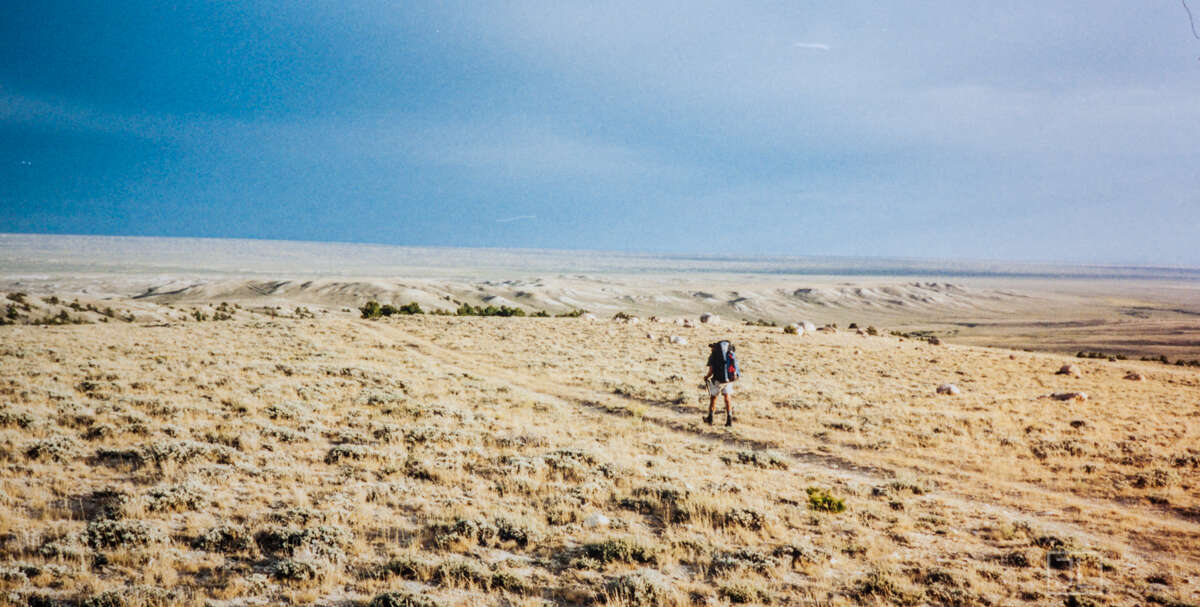
The road passed through patches of sand, our feet sank into the soft sand making progress even slower. We had to alternate between walking on the road, and weaving through the sagebrush next to it. We stopped briefly at a small building that housed controls for a pipeline… only notable because it was “something”.
Darkness came and we were still walking, trying to reach A&M reservoir. It was out there somewhere. The llama packer described it as a recreational reservoir with a parking area and fishing opportunities. It sounded like something to shoot for, we figured it had to be huge. We passed near a hill, somebody with a light was standing on top… A&M reservoir we deduced. We walked up the hill and said hello.
3 guys were already camped there. They were biking from Denver to Portland, taking the scenic route. They were in their early twenties. Two of them had biked from Ohio to Colorado the year before. One of those told us how the idea for that ride had been hatched, “I wanted to go Colorado to work at a ski resort”, he explained, “but I didn’t have a car. So, my old man was like, ‘What? are you going to ride your bikes?’, he was kidding, but I thought, ‘shit, why not’?”. Apparently, long distance bike rides ruined people just like hiking did… they were doing it again. One of them had a mandolin, and for the first time on the trip, I got to play my strumstick with somebody. We jammed-out one long improvised melody for 20 minutes under the desert stars. I thought about the day – how it started, how it developed and how it ended. It was a pretty good day.
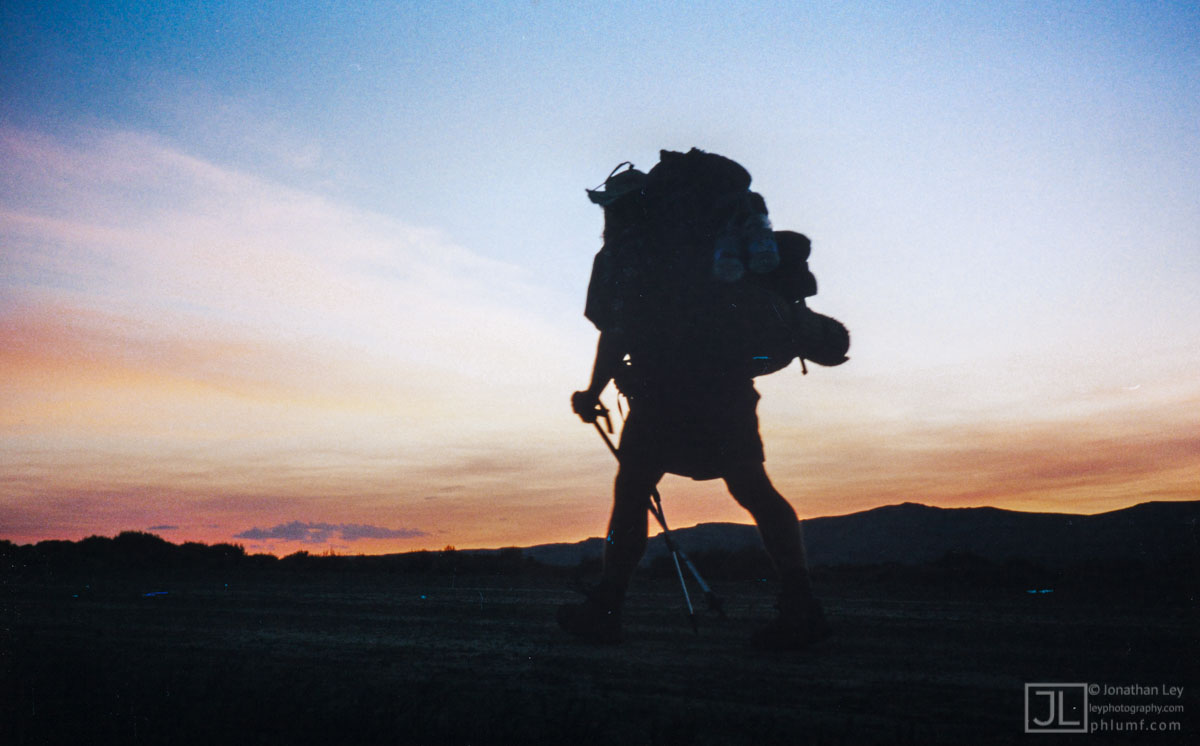
The sun broke the horizon too early the next morning. Within 30 minutes, it went from cold to cool to warm to hot. We got a look at the A&M reservoir. It was the most pathetically hilarious thing I’d ever seen – a small pool of brown water, about 10 yards across, sat in the bottom of a barren earth-dam. It was fenced-off from the cows, but it hardly mattered, there was nothing appealing about the reservoir. In a way it was sort of depressing. I wondered who’s idea it was in the first place? Were they proud of it?
The bikers volunteered to go back and filter water from a stream they’d passed a couple miles back. We headed out when they returned. More flat expanse awaited us.
We drifted apart again. After a couple hours I couldn’t even see Mario or John… somewhere behind me. The sun got higher and hotter with every step. I started to focus-in on every little nuance of sound that my body and pack made – the brushing of nylon, the kicking of sand, my poles digging into the ground. I sung bad 80’s songs in my head, then got frustrated when I couldn’t shut them off, “more than a feeling, more than a feeling…” The road was absolutely straight. I looked at the map, it was one solid straight line for the next 15 miles. At the end was something called Bull Spring – another questionable water source.
Another hour passed. I noticed something odd about a half-mile to the side of the trail. It was some kind of man-made apparatus. According to the map I’d gotten from the BLM guy, a possible water source was nearby. I decided to investigate. If nothing else it was something to keep my mind occupied, and maybe there was water there.
It was absolutely amazing. The apparatus turned out to be a giant solar panel. The solar panel was connected to a well, and out from the well poured clear cold water – straight from deep underground. The water poured into a long metal cattle trough, then drained into a pool 100 yards away. I let out a scream of joy. It was beautiful, if I’d had one wish at the time, it would have taken a shape similar to what was right in front of me. I waved franticly at Mario and John as they walked up the road. They didn’t see me at first, but they see the well, and like me, they had to check it out.
We spent 3 hours at the well. The solar panel provided some shade, I set up my poncho for a little extra. I made frequent visits to the water to wet down my head and my clothing. It was the hottest part of the hottest day of the entire trip. I walked out into the desert sage to feel the heat, to enjoy it. I knew that it was only a few steps to shade and water, so the burning sun was an exhilarating sensation. I thought about all horses and cows and pronghorn out there, defenseless against the sun. I could feel the solar radiation cooking the land around me. I embraced the quiet. Usually, during the day I was walking, and that always made a little noise. There, I listened to the suns rays beat into the ground, into the sage and into me. It was a frightening sound, and it was everywhere.
I didn’t want the solar well experience to end, but like everything, it had to end. I soaked all my clothing, wrapped a wet bandana around my head, and headed back to the trail. I looked back and saw a group of horses approach the well. They stood about 50 feet from the water, nervously checking that everything was OK. One of them, the leader I assumed, slowly approached the trough, head bobbing almost as if he was paying homage to some god. After the leader reached the water, the others slowly followed. Then they all drank. I saw the whole process as a ritual, maybe if they’d done it right, the gods would be appeased and the well would not go dry. But then, we were the gods, and we’d chosen the cows, not the horses… it wasn’t fair. The well would probably be turned-off soon. The horses would keep coming back for a while, wondering what had happened, what had they done wrong… But, they had been living out there a long time before there were any solar wells, they’d manage.
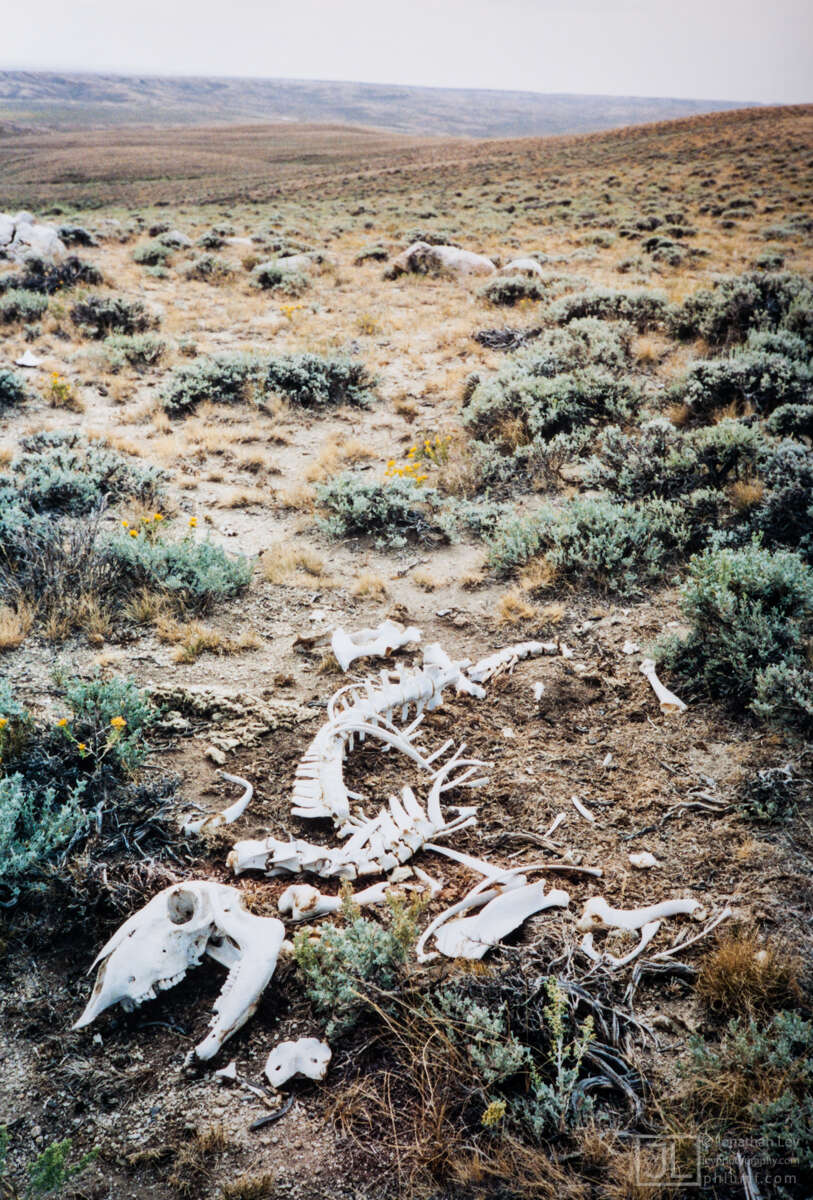
The rest of the day, I found another distraction. The road was nearly paved with petrified wood. I scooped up small pieces as I went along. The wood was naturally polished, beautiful. Each piece was different, some the size of old tires, others the size of paper clips. Some were made of black and grey splotches, others had retained their original deep brown, the grain and texture of wood was plainly visible. I thought of the old swampy forest that was once there, it was another planet then. Sometimes it was easy to see the world as permanent and unchanging, so dominated by the effects and affects of man. There, the rocks told another story, a truer story. They were blatant reminders of the real nature of our world. I thought, when would our trees be rocks? who would pick them up in the desert?
By the end of the day, we’d made it to Bull spring. The spring was another mud-hole, manured by cows. The cows had stepped all over the spring, ruining most of it. While we were there, a few of them stood a hundred yards away, up to their bellies in mud. “Mmmmeeeeuuuu”, they stared at us continuously. We found a tiny trickle of fresh water, draining into a cow-print. Slowly, we filtered the water. It had to do.
I lost myself in serious daydreams and fantasies, taking my mind as far away as possible, the miles rolled by. We were inching closer to Rawlins. It was always hot, the sun blasted us, uninterrupted all day. The road we’d been walking merged with a paved road, and that merged with a highway. The surrounding land was a patchwork of private and public land – the checkerboard. Once long ago, the government sold only every other square mile to private ranchers. I supposed it was intended to isolate property owners or something, maybe prevent ranch monopolies from developing? Whatever the reason, it made hiking through the land impossible. It only took one rancher to say “no” to an easement for the CDT, and few ever said “yes”. They had nothing to gain from the trail – there was no money in it. We hiked over some private land anyway, but soon switched to the road.
Roads were not built to be walked on. The hard pavement made each step resonate through my frame. Each step was the same, used the same muscles, the same way, over and over. My poles rode on top of the asphalt, out of place as much as skis. The rhythm quickly became maddening, click, clack, click, clack… I waited for Mario and John to catch up as I stretched out my aching calves. We had to get off the road.
Salvation came in the form of a van. Bob lived in the desert somewhere, and it showed. His beard was of a style not seen since the 1840’s. His van was filled with random objects that anyone might need, but never do need – old tires, various bottles of fluid, dirty towels, broken tools… His first act was to give us all beers. He was headed to Rawlins to look for a replacement part for a generator that had broken, he was frustrated about it. It took little convincing for us to come along. Walking 12 more miles on pavement next to speeding cars didn’t sound appealing. Bob had done electrical work on the new prison just outside Rawlins. “I was surprised they let me work on it… with my background.”, he said. He went on to tell us that he’d done time in Leavenworth. We all wanted to know more, but didn’t know how to ask, he told us anyway, “Well”, he said with reserved pride, “He shot first, but he missed.” I was sure that Bob had a lot of stories, stories that people like me didn’t often get to hear first hand. But, the ride into Rawlins was brief. Bob dropped us off near one of a dozen cheap hotels that comprised the outskirts of town.
We spent the rest of the day walking around town, visiting the post office, and eating at a place called… “the eating place”. The prison dominated the culture in Rawlins, There was a new prison just outside of town. We never saw it, but it was reportedly huge. The old prison was right in the center of town. We took a tour, I got to sit in the gas chamber. It seemed somewhat warped to me – to think of a prison as a good thing, a bringer of jobs, a repository of history. I had always thought the world would be better off without any prisons at all, that is, assuming we had no need for them. Would the world have been better off without Rawlins? A lot of people who lived there seemed to think so.
The next day was my birthday. Mario and John decided to buy me a portable radio. They each carried one, and I had been sort-of jealous during the more monotonous sections of the desert. I wasn’t sure if I really wanted one myself, but figured I’d at least give it a chance. I went back to the store to get some headphones. The store clerk had talked to Mario and John, and already knew all about me. He gave me the headphones for free, “happy birthday, and have a good hike!”, he said. I didn’t know what say except “thanks” and… “thanks again”. What had I done to deserve that?, I wondered. It made my day, and it made me think there was indeed hope for the place. Somewhere, underneath all the business of the prison, was a little town called Rawlins, striving to make itself known.
In the early afternoon, we headed out of town. We walked past a series of run-down old homes with high wooden fences and dilapidated cars, past crazed barking dogs tied up with ropes inside yards of dirt and dried weeds. We stepped through piles of plastic and Styrofoam trash under the buzz of I-80. We walked toward the mountains, forever south, forever along the divide.